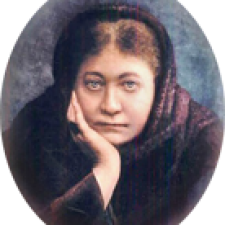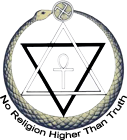H. P. Blavatsky And The Founding Of The Theosophical Society
By Charles J. Ryan
From the Point Loma Publication:
Theosophy: A General View
Theosophy will always be associated with the name of H. P. Blavatsky, and students will early come to realize her unique position as the amanuensis of the Masters of Wisdom in bringing again, particularly to the western world, the age-old teachings of the Wisdom-Religion. By them she was trained to carry out the great work of reformation needed at this low ebb of the spiritual tide.
She expounded, explained, taught the basic concepts of that Wisdom-Religion which has never really died but because of cyclic conditions has many times been lost to general knowledge. It was when she was 20 and on a visit to London from Russia that she met one whom she recognized as her Teacher. From then on she underwent training. She traveled to many parts of the world and spent several years in the fastnesses of Tibet.
In 1875, under instructions from her Teacher, she established the Theosophical Society as a means of restoring Theosophy to the world and thereby building a firm foundation for the Brotherhood of Man. In her day Western civilization was in great danger from the increase of materialism, partly arising from the wonderful discoveries of physical science which seemed to discredit all spiritual interpretation of life. But Religion was also materialistic. On the one hand “blind force,” on the other, rigid dogmatic formalism. A picture of the times may in some respects be seen in these words of the well-known Bulwer Lytton:
Look where we will around us in every direction the sources of pure spiritual life appear to be altogether stagnant, or else trickling feebly in shrunken and turbid streams…Wherever the grandest issues of Humanity are at stake, man’s spiritual attitude towards them is one either of hopeless fatigue or fierce anarchical impatience. And this is the more deplorable because it is accompanied by a feverish materialistic activity. Yes, this age of ours is materialistic; and perhaps the saddest and dreariest thing in the ever-increasing materialism of the age is the ghostly squeaking and gibbering of helpless lamentation made over t by the theologists, who croak their old dry wells wherein no spiritual life is left. Meanwhile society seems to be everywhere organizing animalism. – Fortnightly Review, 1871
H. P. Blavatsky was specially fitted for her mission by brilliant intelligence, dauntless courage and overmastering desire to lift some of the burden of sorrow from the world. Her qualifications included trained occult faculties which enabled her to demonstrate the Theosophical teaching that man has far greater powers than he suspects locked up in his inner nature. She well knew that the work she willingly undertook as the Servant and Mouthpiece of the Masters involved the sacrifice of all that most people hold dear, and that the bitter hostility of the forces of prejudice and reaction would be aroused. Yet she did not hesitate or waver. In spite of having to endure both the crudest and most refined forms of persecution, and of being constantly misunderstood and misrepresented, she succeeded in spreading Theosophy far and wide and in creating a large and active Society of earnest students and workers. Her teachings have powerfully affected modern thought-scientific, philosophic, and religious.
H. P. Blavatsky always repudiated the claim of having invented Theosophy. She had no personal ambition. Again and again, she gave the credit of her teachings to her Superiors, the Guardians of the Sacred Knowledge. Her duty was to present it in a form acceptable to the world. The facts of her career and the study of her writings make any other explanations ridiculous.
She was directed to begin her public work in America, where she arrived (in New York City) in 1874. On November 17, 1875, the Theosophical Society was established by her with assistance of Colonel H. S. Olcott, W. Q. Judge, and others. The remainder of her life was spent in spreading Theosophy by personal teaching, writing books, editing magazines, and establishing Lodges in many countries. She died in London on May 8, 1891 [This day is called White Lotus Day by many Theosophists] In the sixteen years of her public activity the Society gained thousands of members, national and local centers were organized throughout the world, and a large literature was produced.
Her works included Isis Unveiled (1877), The Secret Doctrine (1888), The Key to Theosophy (1889), and The Voice of the Silence (1889). She also edited The Theosophist and Lucifer and wrote voluminously for these and other periodicals. Today her Collected Writings, edited by Boris de Zirkoff, are appearing, ten volumes having already been published, [total volumes finally published are fifteen-BNet]
Back to Theosophical Writings

